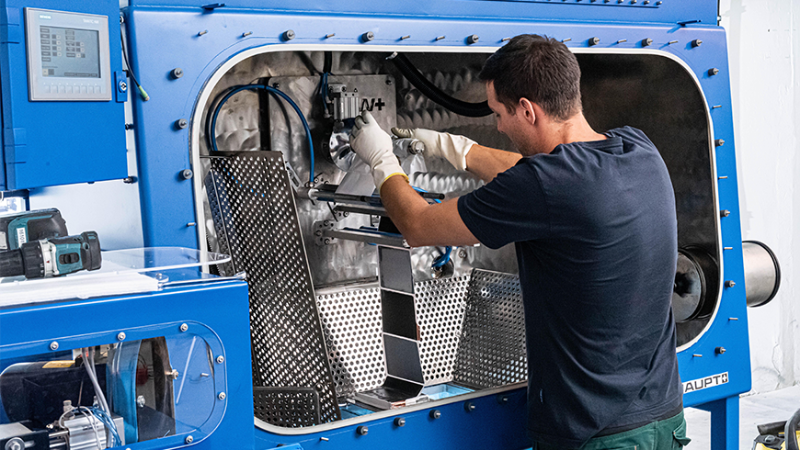Battery-go-round
Everyone is familiar with this phenomenon from their cell phone or laptop: Over time, the capacity of the battery decreases, so that you have to reach for the charger more and more often. The same is true of the much larger batteries in electric vehicles. Although manufacturers can now guarantee a service life of eight to ten years for lithium-ion batteries, sooner or later they too will have to be recycled.
In a project supported by the Swiss Federal Office of Energy (SFOE), the Swiss electric vehicle manufacturer Kyburz Switzerland AG and Empa have set themselves the goal of recycling discarded batteries from electric vehicles. To this end, Kyburz, with the support of Empa researchers, developed a special recycling plant that disassembles old batteries into their components.
Before a battery ends up in the recycling facility, however, it can be given a second, sometimes even a third, life. After its first use in the yellow electric three-wheeled scooters that Kyburz manufactures for Swiss Post AG, it can, for instance, be fitted into second-life vehicles powered by batteries that have already been used. If the battery's capacity continues to decline, even that doesn't have to be the end. Batteries with reduced capacity could be installed in stationary applications for storing solar energy, for example. This "multi-life" concept should significantly reduce the demand for primary raw materials in the future.
Precise separation
If the capacity of the battery is no longer sufficient for any further use, it is finally sent to the recycling facility. "In the type of battery we are currently recycling, the cathode, separator and anode are installed in several layers in a plastic casing," explains Empa researcher Andrin Büchel from the Technology and Society laboratory. By cleverly unrolling the separator, the cathodes and the anodes – metal foils coated with particles which allow lithium ions to be stored – are sorted into two separate containers.
The next step is the recovery of the electrode materials. The cathode, an aluminum foil coated with lithium iron phosphate particles, is placed in a water bath where the particles detach from the foil and, after decanting and drying, are recovered as powder. Exactly the same procedure is followed with the anode, which consists of a copper foil coated with graphite particles. In this case, however, a homogeneous suspension is formed, which means that an extra step in a centrifuge is necessary to separate the particles.
"At the end of the recycling process, we get back the casing, the separator, the aluminum and copper foils, and the electrode materials, all cleanly separated," Büchel says. This type of recycling process is called direct recycling. "In direct recycling, the battery is only disassembled as much as necessary to preserve the functional properties of the materials. This allows us to minimize the number of steps required, including for further processing," Büchel says.
Accurate analysis
But the work is not done with the recovery of the materials. Before they can be used again in a new battery, they have to be regenerated. This is precisely what Büchel is currently working on across various Empa labs with his colleague Edouard Quérel. In the battery lab of the Materials for Energy Conversion laboratory, they have already uncovered the mechanism behind the aging of the cathode material. "The lithium iron phosphate has a crystalline structure that releases and reabsorbs lithium ions during each charge and discharge cycle," Büchel explains. "This structure is preserved, but the amount of active lithium ions decreases over time." Currently, the researchers are aiming to "refresh" the cathode material by selectively adding lithium. The ultimate goal: to build the most powerful new batteries possible from recycled materials and thus close the loop.
In conventional recycling processes, batteries are shredded and the materials are separated using thermal and wet chemical processes. Direct recycling is said to be more resource-efficient in comparison, using less energy and no chemicals. However, the process developed by Kyburz and Empa is currently only suitable for the specific design and cell chemistry of batteries such as those used in Kyburz vehicles. "We are currently investigating whether and how this process can be adapted to other battery cell types as part of the Innosuisse project CircuBAT, involving 24 partners from industry as well as 11 research partners," says Büchel.
